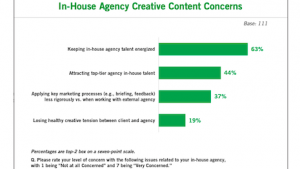 Another case of low energy? Source: ANA In-House Agency Creative Content and Legal Concerns Report
Another case of low energy? Source: ANA In-House Agency Creative Content and Legal Concerns Report
A new report from the Association of National Advertisers claims that marketers with in-house agencies find it difficult to keep their creative teams energized, while also being concerned about their ability to attract top-tier creative talent.
Respondents and interviewees in the survey identified four primary issues with their in-house creative content:
First, keeping in-house agency talent energized, which was the key concern among 63 percent of respondents.
Second, attracting top-tier in-house agency talent, which 44 percent highlighted.
Third, applying key marketing processes – a concern cited by 37 percent of the respondents.
Finally, having healthy creative tension, which was a concern of 19 percent of those responding.
The report called “Managing In-House Agency Creative Content and Legal Concerns” was a collaboration of the ANA, Boston Consulting Group and Reed Smith, the ANA’s outside legal counsel.
The findings were the result of a quantitative survey of 111 ANA members fielded in March 2019, as well as quantitative interviews with ANA members and industry experts conducted in the first quarter of 2019.
Getting creative
In other findings cited in the report, interviewees and survey respondents indicated that they have developed several strategies to keep in-house agency talent energized. Per the report:
- Have creative talent work with multiple internal stakeholders/brands to expose creatives to a wide array of challenges.
- Give internal creative teams particularly challenging projects that will stretch their skills and capabilities.
- Provide training workshops to help employees hone their skill sets.
Regarding the talent, respondents said they employ a number of strategies designed to attract talent, according to the report:
- Creating a virtual team that helps attract talent in less competitive markets. This enables management to identify the right talent in the right location while also maintaining a competitive structure.
- Emphasizing the attractiveness of the total compensation package during recruitment and being prepared to pay for specialized roles. Job security and working hours can be very attractive, especially when coupled with other benefits such as maternity/paternity leave and working remotely.
- Having creative talent cover multiple brands spanning categories. Top-tier creative talent is accustomed to tackling different problems across industries, so when coming in-house, having the ability to work across multiple brands/categories can help alleviate the potential concern of focusing on only one brand or category.
- Reinforcing that creative ideas and concepts developed in-house are more likely to actually be produced than ideas emanating from an external agency.
IN ADDITION to the key creative content concerns that must be managed by an in-house agency, survey respondents were asked about how they manage 16 legal issues identified by the ANA and Reed Smith, according to the report.
Respondents said that while they considered all 16 important, they were already being adequately addressed and were not areas of serious concern.
The top four legal concerns identified by respondents were contracting with talent for appearing in advertising and commercials, trademark clearance, contracting with photographers and SAG-AFTRA or other union issues.
The latest report follows the 2018 ANA study titled, “The Continued Rise of the In-House Agency.” The earlier report found that 78 percent of ANA members have an in-house agency.
